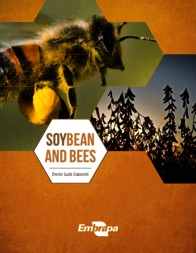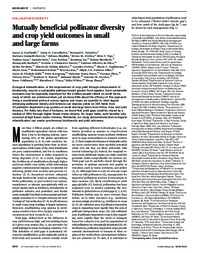Scientists will study pollinators' relationship with soybean crops
Scientists will study pollinators' relationship with soybean crops
A research project in partnership between Embrapa and Bayer is going to study the relationship between pollinating insects and soybean production. Due to last for five years, the project comprises five major research fronts and is expected to further scientific knowledge currently available about such relationship on one of the world's main agricultural crops. Project activities include the capture of volatile substances (aromas), which attract or repel the insects, and the relationship between such pollinators and the productivity of the leguminous plant.
"It is a project with great international scientific relevance. The topic is still understudied and it can positively surprise us, establishing technological opportunities that are very interesting for the soybean production system", explains Décio Gazzoni, researcher from Embrapa Soybeans (Londrina, PR) and leader of the project.
The lines of research include: mapping the habits of the pollinator insects in soybean croplands, identifying the impact of insecticides on the colonies, and strategies to reduce and minimize risks. "We need to understand the behavior of these insects in the croplands and, for that purpose, we are going survey six important producing regions. “With a deeper understanding, we can formulate strategies that align pest control with having minimal impact on pollinators,” stated Gazzoni.
Nowadays, science already knows that the plants "talk" with each other and with the insects through volatile substances. Besides learning more about and scientifically describing the current state of the art of pollinators in soybean crops, a precursory research work is going to attempt to understand how the volatile compounds produced by the soybean plants attract or repel the pollinators. Such findings pave the way for further research on breeding and genetic improvement. "It is a line of research based on chemical ecology, which uses modern techniques to map volatile compounds, which can be active in the communication between the soybean flower and the insects. One of our working hypotheses is that the presence of pollinating insects could complement the fertilization of soybean flowers, thus increasing their productivity".
The first stage of the research stipulates the capture of such volatiles in the air by ultrasensitive suction equipment. Part of the equipment was acquired and some are still being adapted with nozzles and receptors to suck the air and only filter the molecules that will be studied. "We want to understand which substances these are, establish their chemical profile, in which conditions such volatiles are produced by the plants and captured by the insects. The flowers, for instance, vary their production of the volatiles throughout the day according to temperature and moisture. We want to identify which reactions take place and how the bees react to such changes", the researcher.
Another research stage comprises studying the bees. Through specific equipment, it is possible to assess whether the bees are being attracted or repelled by the plants. If the presence of such insects is related to soybean productivity, for instance, means to lure them to soybean fields will be developed, as Gazzoni details: "through genetic improvement, we will be able to introduce traits in the plants to attract more bees or use the information available in pest management programs", he plans.
In another research front, Embrapa is going to study the relationship between domestic and native bee diversity, and population size and its relationship with soybean productivity. "The aim is to establish the correlation between bee diversity and soybean productivity", details Gazzoni. Embrapa and Bayer's current genetic materials will also be assessed for resistance to stink bugs, whose final aim is to reduce the use of agrochemicals to control such pests, resulting in lower impact on pollinators.
The study also includes the production of books on the subject. One of them will detail the relationship between soybean and bees; the other is going to describe the plants that can be important alternatives to attract and protect pollinator insects. With the approval of the project, Embrapa is going to expand their research network, involving other national institutions.
"At Bayer, we are committed to research to improve our understanding of the health requirements of such important insects that contribute to pollinating different crops. We understand that pollinators are essential for the sustainability of agriculture. The partnership with Embrapa is going to help us in the development of new studies for Brazilian conditions", asserts Bernard Jacqmin, Bayer 's director of Agronomic Development in Latin America.
Understanding the interaction between insects and plants
While human beings communicate through words and gestures, for example, insects live in a complex world of chemical stimuli that affect their behavior. The signals that allow for communication among insects are called semiochemicals, volatile chemical substances that can be used in the interaction between individuals of the same species (pheromones) or between different species (allelochemicals).
Pheromones dictate sexual behavior, territorial marking, alarm and recognition. Insects are extremely sensitive to the pheromones, so much that a millionth microgram expelled by a female is enough to attract a male at long distances. In turn, allelochemical release occurs in stressful situations, when the insect emits an odor to repel predators. Chemical Ecology is the science that has been studying such interactions for approximately 40 years.
The research project between Embrapa and Bayer aims at finding answers regarding the relationship between pollinator insects and soybean cropping. The Embrapa Soybean researcher Décio Gazzoni explains that the project intends to identify which volatiles are present in the relationship between soybean plants and pollinators, and the chemical composition of such substances, and also verify which action a given volatile emitted by the plant triggers in the insect or the other way around. "We want to understand attractiveness and even occasional repellence factors that exist between soybean and bees to use the knowledge in soybean breeding and in the conservation of pollinators", explains Gazzoni.
Carina Rufino (MTb 3914/PR)
Embrapa Soybean
Press inquiries
soja.imprensa@embrapa.br
Phone number: +55 43 3371-6061
Gustavo Porpino (MTb 648/RN)
Embrapa's Secretariat of Communications
Lebna Landgraf (MTb 2903/PR)
Embrapa Soybeans
Further information on the topic
Citizen Attention Service (SAC)
www.embrapa.br/contact-us/sac/



